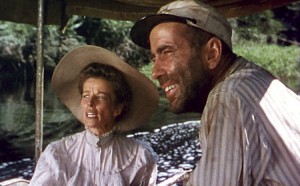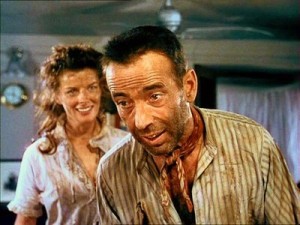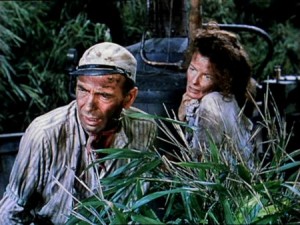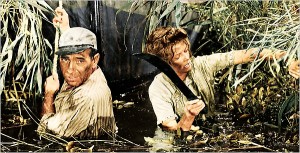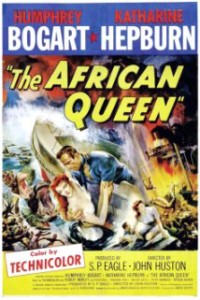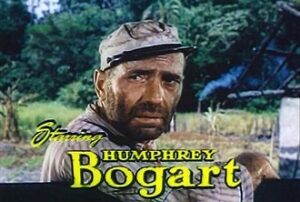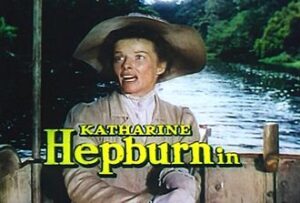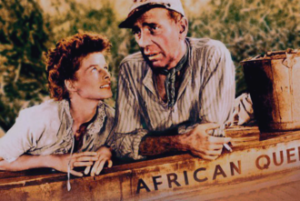The African Queen ***** (1951, Humphrey Bogart, Katharine Hepburn, Robert Morley, Peter Bull) – Classic Movie Review 327
Humphrey Bogart and Katharine Hepburn lighting electric sparks off each other on screen together is the main attraction of the enchanting 1951 British-American romantic adventure drama movie The African Queen.
Along with their stupendous star playing, it is the combination of the effective direction by John Huston, Jack Cardiff’s beautiful Technicolor cinematography and James Agee and Huston’s witty screenplay that help to make it one of the cinema’s all-time best-loved films.
Bogart and Hepburn form a dream team in this perfect adaptation of C S Forester’s 1935 romantic adventure novel. Bogart is the grouch to end all grouches, playing off his co-star’s character which would be annoyingly abrasive if Hepburn hadn’t brought in the all-important touch of humour when Huston told her to play her character Rosie as if she was playing Eleanor Roosevelt.
Both of the stars by rights should have won Oscars, and both were nominated. But in the event it was Bogart who won a deserved Academy Award for Best Actor (his only Oscar) as Charlie Allnut, the tough, grumpy, drunken, gin-swilling owner/ captain of the dilapidated river steamboat African Queen.
It’s September 1914, a dangerous time at the start of the First World War, and German imperial troops burn down the mission of the Reverend Samuel Sayer (Robert Morley) in the colony of German Eastern Africa. He is beaten up and dies of fever, and his sister Rosie buries him and leaves by the only available transport, the African Queen.
And so it is that captain Charlie Allnut reluctantly accompanies the snobbish, prim and proper, strait-laced, and of course unmarried missionary Rosie down the Congo supposedly to safety.
Naturally the duo are destined to bicker and quarrel epically and delightfully as they battle the river, the rain and eventually the German Kaiser’s navy when the fearless missionary persuades the captain to use his boat to attack a huge German warship, the Königin Luise, captained by the Captain (Peter Bull). Forester ensures that it is quite a grand, eventful yarn.
Peter Swanwick, Theodore Bikel, Walter Gotell and Allo, Allo!’s Richard Marner are also among the small cast, making small roles count.
Hepburn recalled the story of the film’s shoot under difficult circumstances in her 1987 memoir The Making of The African Queen. Clint Eastwood starred as Huston in White Hunter Black Heart, the 1990 film of Peter Viertel’s book White Hunter Black Heart about the making of this movie.
The film is produced by Sam Spiegel and John Woolf. The score is by Allan Gray.
The African Queen was selected for preservation in the US National Film Registry in 1994, deemed by the Library of Congress as culturally, historically or aesthetically significant.
Unusually for 1951, much of the film was shot on location in Uganda and the Congo in Africa but about half the film was shot in the UK. The scenes in which Bogart and Hepburn are seen in the water were thought too dangerous to shoot in Africa, and were all shot in studio tanks at Isleworth Studios, Middlesex. All the foreground plates for the process shots were also filmed in the UK studio.
Cast and crew endured sickness and spartan living conditions on location. In the scene when Hepburn plays an organ in the church, a bucket was placed off-camera in which she could vomit between takes because she was sick. Bogart later boasted that he and Huston were the only ones who escaped illness on location thanks to drinking whisky rather than the local water.
Censors objected to a number of aspects of the script, including the idea of unmarried characters cohabiting the boat, and various changes were made. Bogart was unwilling to attempt his character’s thick Cockney accent and the dialogue in London dialect, so the script was rewritten to make the character Canadian.
The small steamboat used as the African Queen was built in 1912 in Britain for service in Africa, and was once owned by actor Fess Parker It was restored in April 2012 and is now a tourist attraction in Key Largo, Florida. Key Largo will be remembered as a 1948 film with Humphrey Bogart.
The cast are Humphrey Bogart as Charlie Allnut, Katharine Hepburn as Rose Sayer, Robert Morley as the Reverend Samuel Sayer, Peter Bull as the Captain of the Königin Luise, Theodore Bikel as the First Officer of the Königin Luise, Walter Gotell as the Second Officer of the Königin Luise, Peter Swanwick as the First Officer of Fort Shona, Richard Marner as the Second Officer of Fort Shona, and Gerald Onn as Petty Officer of the Königin Luise.
The film runs 105 minutes.
It premiered at the Fox Wilshire Theatre in Beverly Hills on 28 December 1951 to qualify for the 24th Academy Awards, and opened in New York City at the Capitol Theatre on 20 February 1952.
The film was partly financed by the British company Romulus Films of John Woolf and James Woolf, who invested £250,000 and later convinced John Huston to direct their next film, Moulin Rouge (1952). The film cost $1 million and earned $10,750,000, so it was a nice little earner.
© Derek Winnert 2013 Classic Movie Review 327
Check out more reviews on http://derekwinnert.com

